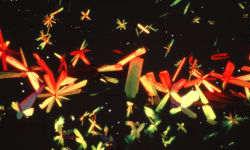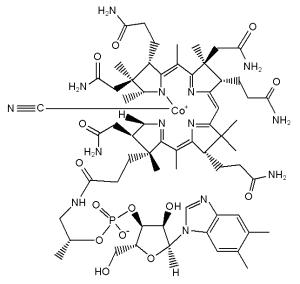

 |
 |
 Vitamin B12 Crystals Copied without permission from Roche Product Information |
Vitamin B12The term vitamin B12 refers to a group of molecules called cobalamins which all contain cobalt. These include:
Chemical Structure Fig.1 The Chemical Structure of Vitamin B12 Copied without permission from Roche product information. 3D Structure of Vitamin B12 Top Principal Sources in FoodThe main dietary sources of vitamin B12 are animal products for example:
Top Vitamin B12 in the BodyLike the other members of the B-complex, vitamin B12 is involved in the cellular metabolism of carbohydrate, protein and fat and in the production of:
StabilityVitamin B12 is stable to heat but is sensitive to light, oxygen, acid and alkali.Top SynthesisThe industrial production of vitamin B12 involves bacterial fermentation.Top |